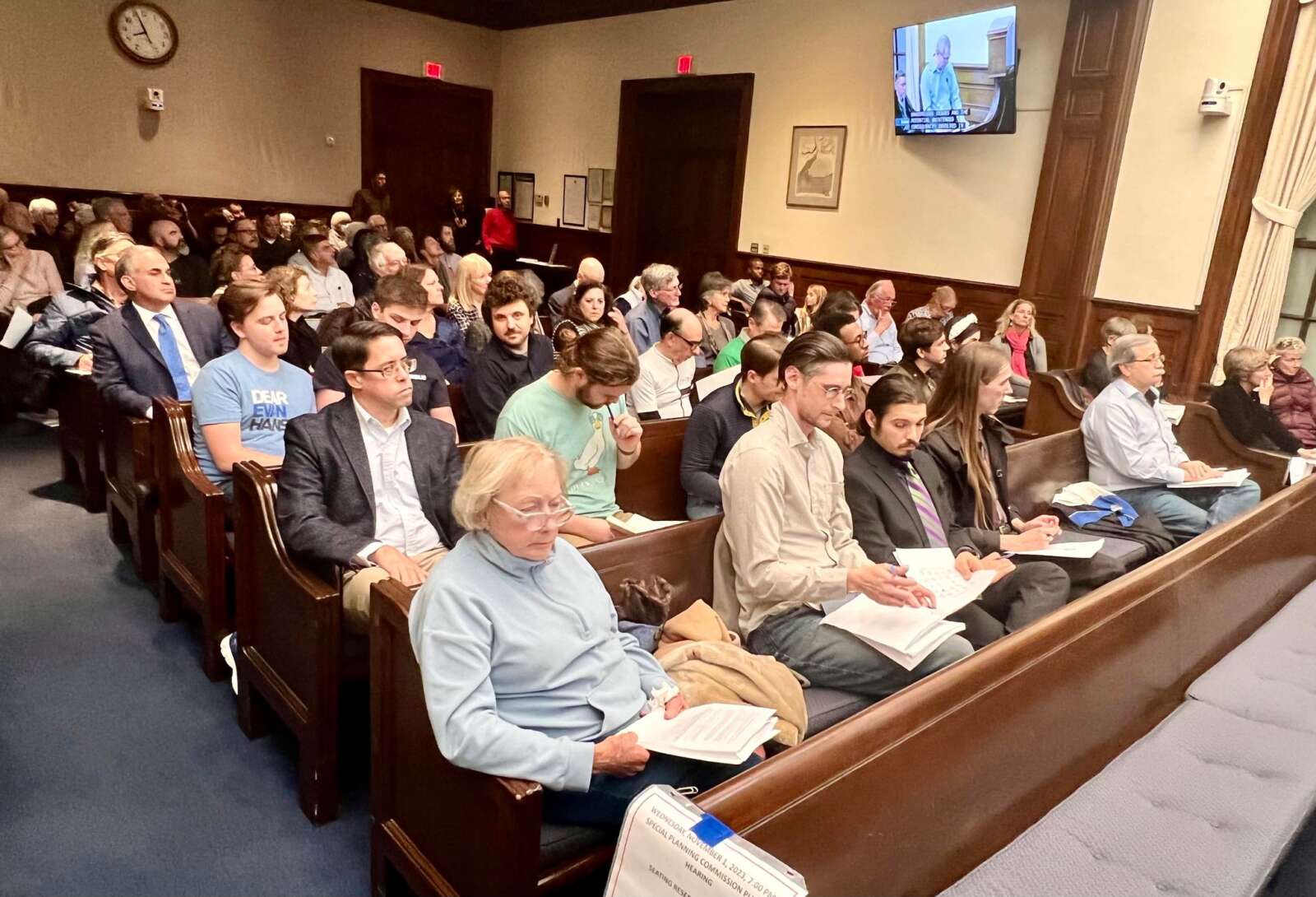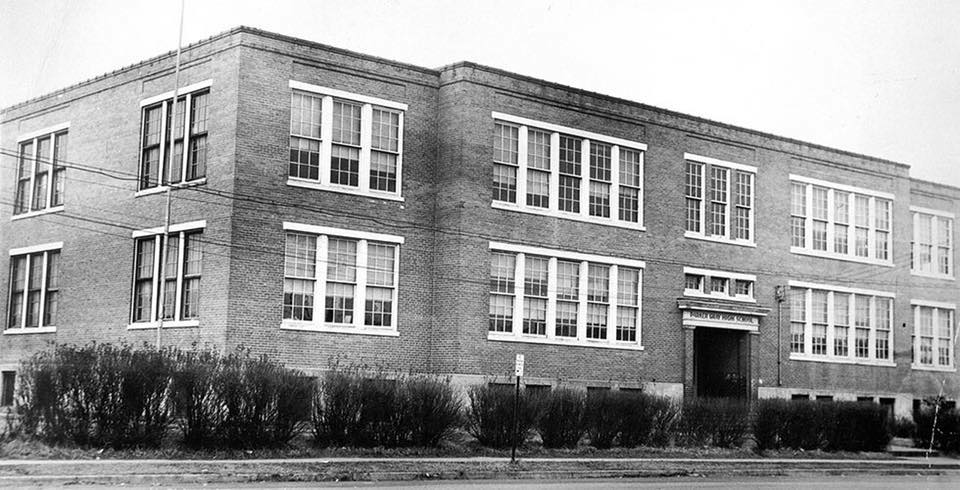
The Alexandria Planning Commission unanimously endorsed a sweeping overhaul of the city’s zoning ordinances on Wednesday night, giving City Council the green light to vote on it later this month.
There were more than 100 attendees and 51 speakers at the Planning Commission’s five hour public hearing, which ran after midnight. The speakers were a mixed bunch, with about half supporting the legislation and the other half opposing it.
The Zoning for Housing overhaul is intended to expand new affordable housing opportunities and would reshape a host of ordinances, including changes to single-family zoning, expansion of transit-oriented development, reducing parking requirements for single-family homes and analyzing office-to-residential conversions.
“I think we’re going to have to be nimble with this,” said Planning Commission Chair Nathan Macek. “I do think, though, we want to be careful with this particular market, and given the challenges that this distressed office space has already, we just have to be sensitive of the fact that we not douse the potential for the development because we’re trying to put too many constraints on it.”
City staff tabled one initiative — a bonus height amendment that incentivizes developers to add affordable housing to projects in exchange for two additional stories of construction in areas where height limits are 45 feet or more. Del Ray residents protested the move, with many saying that its approval would destroy the neighborhood.
“Staff’s recommendation is to table this proposal as several existing zoning provisions, that are not proposed to change under this package of reforms, would severely curtail this provision’s regulatory and financial viability,” according to a staff report.
Prior to the meeting, Mayor Justin Wilson said on social media that the city’s zoning laws are outdated. Wilson said that the proposed policies will desegregate the city, and that a number of zoning ordinances in the 20th century divided the city by race.
Alexandria is having a spirited conversation about laws that prohibit building anything but detached single-family homes.
8 NEW CONSTRUCTION detached, single-family homes have sold in 2023:
AVERAGE sale price: $2.17M
LOWEST sale price: $1.90M pic.twitter.com/2krQ1uXw5D
— Justin Wilson (@justindotnet) October 31, 2023
Alexandria’s affordable housing crisis
Alexandria is currently experiencing an affordable housing crisis, and lost 90% of its affordable housing stock between 2000 and 2017. The city has pledged to produce or develop thousands of units to meet 2030 regional housing goal set by the Metropolitan Washington Council of Governments.
According to the city:
According to U.S. Census figures, nearly twenty percent of Alexandria’s 80,000 households with incomes up to $75,000 are cost burdened. Approximately 19,000 households are paying more than the federal government indicates they should for housing, leaving little in their households budgets for necessities. The City projects that the number of households in Alexandria will rise to about 100,000 households by 2035. The longstanding imbalance between housing supply and demand, exacerbated by stagnating wage growth particularly in low to moderate-wage sectors, is a key factor underlying the high cost of housing, imperiling our ability to grow an economy that depends on a diversity of skillsets.
Alexandria middle school teacher David Paladin Fernandez said that many of his fellow teachers can’t afford to live in the city.
“I know multiple educators that live outside of Alexandria, some as far away as Fredericksburg,” he said. “They don’t live in these places because it’s convenient. They live in these places because that is where they can afford to live, meaning they will not be able to connect to the community in the same way a resident can. They will not have the benefit of the students and parents seeing them as fellow citizens of Alexandria, despite the fact that they’ve chosen to give their lives to serve the city.”
The city conducted dozens of public meetings for more than a year on the Zoning for Housing proposals, but only released a draft plan in September.
“The sessions have focused on general issues and goals, not specific proposals,” said North Ridge resident Sonny Yoder, who asked for a deferral. “Full disclosure came only 30 days ago.”
Luca Gattoni-Celli, founder of YIMBYs of Northern Virginia, said that the city can solve its affordable housing crisis and shouldn’t fear the solution. Gattoni-Celli lives in the West End, surrounded by thousands of city residents living in apartments, he said.
“Living near thousands of other human beings is nothing but a blessing for me and my family,” he said. “It’s wonderful.”
West End resident Kursten Phelps said that she got lucky eight years ago when she got a $5,000 raise and that she and her family were then able to afford to buy their home.
“We got very, very lucky,” Phelps said. “Many of our kids friends are being squeezed out of Alexandria because their rents are rising and there’s no available homes in their budget.”
Ian Smith, 24, has been living in an Alexandria duplex for the last three years, and said that young residents find it nearly impossible to afford to live in the city.
“Even though we get college degrees and work hard for our competitive jobs in the DMV area, basic aspirations like owning a home and starting our own families seem completely out of reach due to the cost of living,” Smith said. “We desperately need housing. This initiative is a great first step.”
Many city residents pleaded with the Planning Commission to defer the proposals, and said that the public has not had enough time to discuss the draft plans.
Roy Byrd, a 25-year city resident, is chair of The Coalition for a Livable Alexandria, a group founded this year largely in opposition of these rezoning issues. He said that there are several unknown variables that the public needs to understand.
“Will the median cost of a single-family home decline or increase by how much year-over-year over the next 10 years?” Byrd asked. “Will the proposed zoning changes result in an increase in revenue for the city, and if so, by how much during the 10 year period, and will it also result in lower property taxes and reduced fees for residents?”
City Council will conduct a public hearing on the Zoning for Housing package on Tuesday, Nov. 14, followed by a public hearing on Nov. 18 and a vote on Nov. 28.
More details on the draft initiative are below the jump.
- Historic development patterns (citywide)
Purpose: Identify favorable historic development patterns within the city’s historic districts and established neighborhoods and provide recommendations that would allow these types of development to be built in the future.
Recommendation: Phased approach.
- Phase 1: Remove dwelling units per acre limitations in multifamily zones to allow smaller unit sizes within the same development envelope. Remove zone transition setback requirements, which require additional setbacks when adjacent to residential zones regardless of the actual use of the properties and the proposed new construction. Implement the Zoning for Housing townhouse zone recommendations.
- Phase 2 (for future study): Simplify the number of zones, change or eliminate minimum lot size requirements, create more standardization of uses across zones, and study increasing flexibility of bulk and area regulations; Create design guidelines for traditional neighborhood development; Evaluate the potential of selective use of the Neighborhood Conservation District tool to preserve existing examples of historic development, especially small-scale multi-family buildings and other housing types not currently being constructed.
Equity Impacts: Removing restrictions on units per acre would allow smaller units to be constructed, which could marginally improve affordability.
Estimated Unit Yield: Approximately 60 over ten years. Units per acre limitations can reduce building yields by 1.5 to 2.5 units per building, depending on project. In Alexandria, 5-10 buildings are under construction at any one time. Smaller unit sizes can help with affordability. Relaxing this extra setback requirement can allow some additional square footage per building, which would further increase unit yields, but it is highly location dependent.
2. Expanding housing opportunities in single family zones
Purpose: Broaden access to traditionally single-family only neighborhoods. Evaluate the current limit of one household per lot in single-family zones and the potential benefits of allowing a greater number of households per lot in those zones.
- In support of this purpose, examine changing the definition of “family” in the Zoning Ordinance and how parking reductions are both possible and necessary to achieve housing access goals, as well as preserve open space.
Recommendations: One of two options to add different housing typologies to single-family zones. Neighborhood compatibility would be safeguarded with either option as existing requirements for minimum lot size, setbacks, open space, floor area ratio, and tree canopy coverage would be unchanged.
Estimated Unit Yield: Approximately 150-178 units over 10 years on 66 parcels. The potential increase in use of the transportation network, water and sewer systems, open space network, and public school system is extremely minor.
3. Expansion of transit-oriented development
Purpose: Analyze existing barriers that limit increased development densities around transit stations. The purpose is to identify themes to guide future small area plans so that they better support densities near high-capacity transit.
Recommendations:
- As part of the upcoming Duke Street corridor plan, evaluate undeveloped or underdeveloped land adjacent to the King Street Metrorail station, both public and private.
- Review the Braddock Metro Neighborhood Plan’s requirements for non-residential development immediately adjacent to the Braddock Road Metrorail Station.
- As part of the Alexandria West Small Area Plan and upcoming Duke Street corridor plan, promote transit-oriented levels of development to support affordable housing.
- Conduct a future study on removing parking requirements for affordable housing within ½ mile of a Metrorail station.
4. Industrial zones analysis
Staff recommendation: Because the majority of industrial-zoned land is already planned for mixed-use redevelopment, the regulatory framework is in place to support housing in those locations. For example, the Eisenhower West Plan envisions redevelopment to include or accommodate some uses now defined as industrial, or located in “industrial” buildings, when those uses have limited offsite impacts and can co-exist well with housing. The recommendation is to provide criteria for new non-residential construction in the industrial zone to promote its compatibility with future redevelopment. Major land uses changes (i.e., adding residential uses or other potential changes) for industrially zoned land south of Duke Street will be addressed by the upcoming Duke Street corridor plan.
Estimated Unit Yield: 3,000-4,000 housing units are planned for land now zoned industrial over the next 25-30 years. This recommendation supports that transition. The impact of these units on infrastructure and public facilities is already addressed by the relevant small area plan.
5. Coordinated Development Districts
Recommendation: Establish a City Council policy, possibly memorialized in the Housing Master Plan, affirming that the City should continue its practice of including condition language in future new and amended CDD requests that would require 1/3 of bonus density (above what is recommended in a small area plan) to be committed affordable units.
Equity Impacts: Increasing the number of committed affordable housing units in the city helps to improve housing inequality. It would also locate more affordable units in CDDs where they would be close to transit and jobs opportunities.
Estimated Unit Yield: 0-400 units per CDD, of which 1/3 would be affordable, assuming that additional density requests will vary between 0-400,000 square feet.
Areas of Applicability: CDDs will be used to implement Eisenhower East, Eisenhower West, some portions of the remaining Landmark/Van Dorn Plan, and likely Alexandria West not already covered by a CDD. Not all CDDs will request additional density. CDDs contain within them conditions to ensure that infrastructure and public facilities needs are met.
6. Residential Multi-Family (RMF) Zone Analysis (citywide)
Recommendations: Amend the Housing Master Plan to state that it is envisioned that the RMF zone can be located in areas planned and/or zoned for medium or higher density development, as well as other specific locations where the proposed project is compatible with adjacent development and consistent with City policies. While this amendment will set the City policy, each project will still have to request all necessary approvals, evaluate impacts, and involve a community process.
Allow more flexibility for ground floor uses and permit uses that currently require special use permits.
Equity Impacts: Amending the Housing Master Plan will provide more intent regarding where RMF projects are consistent with City policy.
Estimated Unit Yield: Approximately 1,800 over ten years. The five RMF projects approved to date have provided a total of 1,840 housing units, of which 1,079 are committed affordable. This initiative has the potential of adding a similar number of additional units over the next decade, but each project would require significant subsidy which can limit future production.
7. Office-to-residential conversions analysis
Purpose: Determine if the City’s current approach to conversions should be confirmed or amended. Investigate whether the Zoning Ordinance includes impediments to office-to-residential conversions and whether there are areas in the city where conversions should be incentivized or discouraged.
Recommendations:
- Continue to work with the development community to support conversions in Class B and C office buildings that can be approved under the current Zoning Ordinance.
- Continue with the City’s current policy to generally encourage conversions of older, obsolete or non-competitive buildings and discourage cases where the building remains competitive or in cases where City policies or plans provide guidance that use should be preserved or the location should remain non-residential.
- Establish a City Council policy, possibly memorialized in the Housing Master Plan, affirming that conversions should use Section 7-700 to increase the residential density on the site, in exchange for affordable housing
- Work with Office of Climate Action and the City Attorney to develop conversion standards for Green Building.
- Review the City’s voluntary affordable housing contribution policy for conversions during the Housing Master Plan Update to ensure the contribution is aligned with the City’s residential affordable housing contribution policy and reflects the value of the change in use, and pursue legislative authority to enable the City to make all voluntary affordable housing contributions mandatory.
- Continue to monitor conversion activity for ongoing challenges; when identified, consider whether regulatory or financial tools are needed. Future reviews will focus on whether building or fire code issues are creating challenges.
Equity Impacts: Conversions can increase the number of available residential units in job-rich areas well-served by existing and future transit options. Given the costs of conversion and restrictions on the City’s ability to require affordable housing, the overall number of new designated affordable units may be limited.
Estimated Unit Yield: 1-3 affordable units per conversion, depending on individual case, for those cases that need the additional density.
8. Townhouse Zoning Analysis
Purpose: Identify opportunities to increase consistency in zoning rules (lot requirements, Floor Area Ratio, and bulk/open space regulations) across the zones that allow townhouses. Revise lot, bulk, open space, and parking requirements to allow for small scale residential infill development in zones that permit townhouses without public hearing approval.
Recommendations: Overall simplify the regulation of townhouses and townhouse-like homes through a phased approach:
- Phase 1: Apply RM zone townhouse lot, bulk, and open space requirements to all properties within Old Town in zones that allow townhouses. Apply RM lot, bulk, and open space requirements to single and two-unit dwellings on narrow lots where townhouse dwellings are currently permitted in Old Town. Establish contextual front setback requirements for townhouse zones and for residential development in commercial zones City-wide. Eliminate side yard setback requirements for lots 25 feet in width or less. Establish 35 percent open space requirement across all townhouse zones and for residential uses in commercial zones. Eliminate off-street parking requirements for single-unit, two-unit or townhouse dwellings within the Enhanced Transit District and require one space per dwelling unit for dwellings outside the Enhanced Transit District.
- Phase 2 (for future study): Replace open space requirement with a maximum lot coverage requirement. Eliminate lot size minimums. Apply RM zone FAR maximum to all townhouse zones.
Equity Impacts: Removing inconsistencies across lot, bulk, and open space regulations would grant similar development opportunities currently only afforded to property owners within the RM zone.
Estimated Unit Yield: These recommendations will make constructing these homes less costly, but are not expected to increase the pace of construction. Reduction in parking requirements reflects assessment of parking demand and use of non-auto forms of transportation already existing or planned.
Recent Stories

Good news, D.C. area. You can save money on your next home cleaning with Well-Paid Maids. It’s easy!
We offer a discount when you set up recurring cleans — and the discounts just increased this week!
For weekly cleans, get $30 off each cleaning.

Potomac Harmony is Back! Following a gap year of competing, then virtual rehearsals during the pandemic, followed by the well-earned retirement of our long-term director, a year of a director search, Potomac Harmony hit the regional contest stage in Concord, North Carolina in March for the first time since 2018! It was exhilarating, reaffirming, and rewarding!
The chorus hit all of its goals, the biggest of which was to have fun and sing our best on contest stage — we did both! Because we earned a score over 400 points, our new Director, Allison Lynskey, was awarded the Novice Director award, photo above. Additionally, one of our charter members, Jackie Bottash, was nominated for and honored with the Leadership Excellence award. It was a celebratory weekend!
What’s next? So much! We now look forward to upcoming performances, growing our membership, and expanding our musical product with new arrangements and an education component each week. It’s an exciting time to be part of this ever-growing ensemble!
Alexandria NAACP, Shiloh Baptist Church, DPC to hold City Council…
The Alexandria Branch of the NAACP, Shiloh Baptist Church, and The Departmental Progressive Club to hold the City Council Candidate Forum for ALL Candidates in the City of Alexandria Virginia. The event is Free of Charge and Open to The






